Imperfections, Artifacts, Corrections -- Oh My!
| Power Pitch Session: How it Works | |
|
1st Hour: 2-minute Power Pitches inside the Power Pitch Theater. 2nd Hour: 60-minute Digital Poster Presentations at the numbered plasma screens outside the Power Pitch Theater. |
1st Hour
Pitch: Imperfections, Artifacts, Corrections -- Oh My!Power Pitch
Acquisition, Reconstruction & Analysis
Wednesday, 15 May 2019
Power Pitch Theater C - Exhibition Hall
15:45 - 16:45
Moderators: Craig Meyer, Signe Johanna Vannesjö
2nd Hour
Poster: Imperfections, Artifacts, Corrections, Oh My!Power Pitch Poster
Acquisition, Reconstruction & Analysis
Wednesday, 15 May 2019
Power Pitch Theater C - Exhibition Hall
16:45 - 17:45
| Plasma # | |||
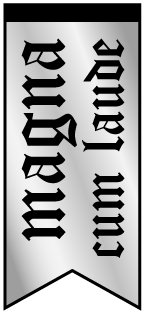 |
0921. 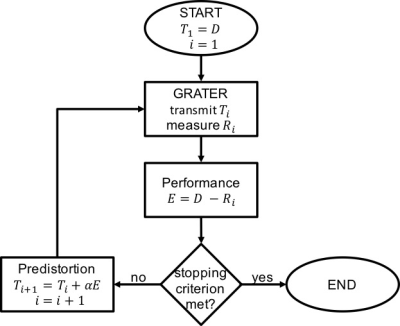 |
31 | GRATER-based RF pulse predistortion improves multiband bSSFP imaging
Vanessa Landes, Krishna Nayak
We present a hardware-free way to mitigate RF envelope error that has the potential to be extremely fast (<1 min), and to benefit simultaneous multislice (SMS) balanced steady-state free precession (bSSFP) imaging. This approach improves RF waveform fidelity 9-fold in a variety of multiband pulses, and correspondingly reduces bSSFP spurious side-lobe excitation 3-fold. This provides 4-fold reduction in SMS bSSFP side-lobe signal.
|
 |
0922. 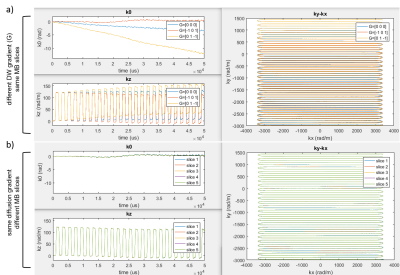 |
32 | Correcting Eddy Current Induced Geometric Distortion for High Resolution Multi-Band Diffusion Weighted SE-EPI with Magnetic Field Monitoring at 7T
Ruoyun Ma, Mehmet Akcakaya, Steen Moeller, Edward Auerbach, Kamil Ugurbil, Pierre-François Van de Moortele
DW-EPI suffers from geometric distortion induced by eddy current from strong diffusion gradients. Magnetic field monitoring using 19F probes followed by algebraic reconstruction incorporating higher order field perturbation has been proposed to address such issue and was applied for single-band acquisition at 3T. In this study, this approach was implemented for high resolution multiband in vivo brain DW-EPI acquisition at 7T, taking into account of scanner imposed global phase modulation for eddy-current correction. Preliminary results showed successful correction of the geometric distortion across all diffusion gradients. Further investigation needs to be made to increase the SNR of DW images.
|
 |
0923. 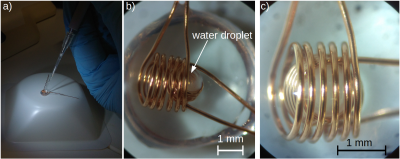 |
33 | Frequency adjustable magnetic field probes
Niklas Wehkamp, Elmar Fischer, Philipp Rovedo, Jürgen Hennig, Maxim Zaitsev
A new manufacturing method for the creation of magnetic field probes is presented. The method allows realizing field probes that can be frequency adjusted during MR acquisition. This opens up new possibilities for the use of field probes during MR experiments. In the presented proof-of-concept case, the field probe’s position in a standard gradient echo experiment was shifted within the field of view by changing its Larmor frequency using an additional micro-coil.
|
 |
0924. 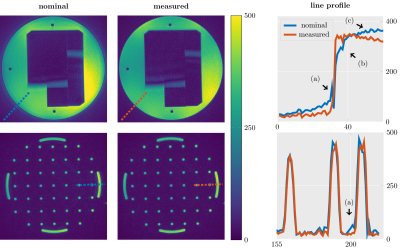 |
34 | Trajectory correction for ultrashort echo-time (UTE) imaging based on the measurement of the gradient impulse response function (GIRF) with a thin-slice method
Sophia Kronthaler, Jürgen Rahmer, Peter Börnert, Dimitrios Karampinos
Reconstruction of high-quality ultrashort echo-time UTE images requires precise knowledge of the dynamic gradient magnetic fields used to perform the spatial encoding during the ramp up of the gradients. System delays and eddy currents can perturb the gradient fields and significantly degrade the image quality. The present study proposes the measurement of the gradient transfer response function with standard scanner hardware to correct the UTE readout gradients and to improve UTE image quality.
|
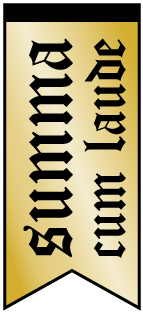 |
0925. 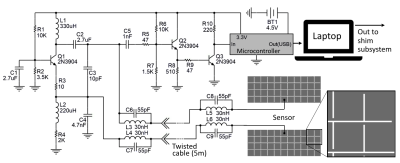 |
35 | Real-time shimming in the cervical spinal cord using an 8-channel AC/DC array and a capacitive respiratory sensor
Ryan Topfer, Nibardo Lopez Rios, Alexandru Foias, Nicolas Arango, Lawrence L. Wald, Jason P. Stockmann, Julien Cohen-Adad
Spinal cord imaging remains challenging in large part due to the temporal variations in B0 caused by respiration. This study introduces a simple circuit design for a capacitive respiratory sensor and demonstrates the utility of this device in the context of real-time shimming the neck using an 8-channel "AC/DC" (integrated RF receive + multi-coil shim) array. Using this approach, motion artifacts in a multi-echo T2*-weighted acquisition are shown to be considerably reduced.
|
0926. 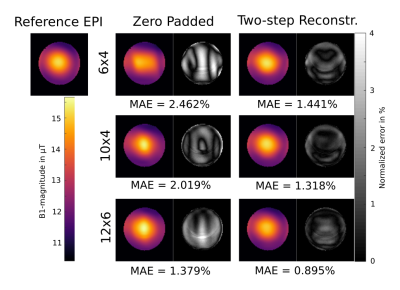 |
36 | 3D Bloch-Siegert EPI B1+-mapping
Andreas Lesch, Christoph Aigner, Stefan Spann, Matthias Schloegl, Rudolf Stollberger
In this work we investigate the feasibility of a double shot acquisition for 3D Bloch-Siegert B1+ mapping. Therefore, we combine the previously proposed variational reconstruction algorithm for highly subsampled Bloch-Siegert data with an EPI readout. The acquired dataset was retrospectively under-sampled and the reconstruction results are compared to the fully sampled reference, a zero padded low resolution estimate and to results acquired with a much more robust GRE readout. We can show that the results are in good accordance to the fully sampled reference and the GRE acquisition for acceleration factors of up to 100 making double shot acquisition possible.
|
|
0927. 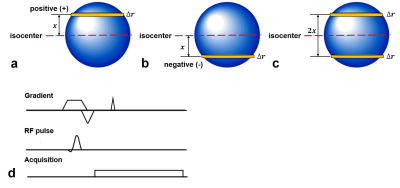 |
37 | Accelerate GIRF measurement using an interleaved off-isocenter method
Guangqi Li, Shuo Chen, Hua Guo
Gradient impulse response function (GIRF) can be used to characterize gradient systems. GIRF measurements typically require multiple triangular waveforms of different durations to be played in three gradient axes. Using the traditional method, the entire measurement takes more than 10 hours. In this study, we propose an interleaved off-isocenter method to measure GIRFs. It can save nearly 50% of measurement time. The measured results are consistent with those measured using the time-consuming traditional method.
|
|
0928. 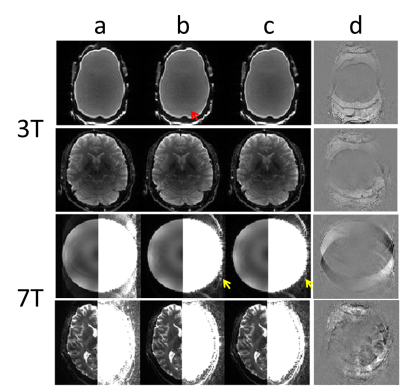 |
38 | Inter-frame phase alignment for Echo Planar Imaging calibration data acquired with opposite read-out polarities
Yulin Chang, Kun Zhou, W. Scott Hoge, Uvo Hoelscher, Wei Liu, Jonathan Polimeni
Echo-planar imaging is subject to Nyquist ghosting due to its use of fast gradient switching. To correct for this artifact, several methods have been proposed that involve a pair of calibration imaging frames acquired with opposite readout polarities. We show that a small, relative shift in the phase-encoding direction often exists between these calibration frames that may lead to compromised image quality. A simple method is proposed to account for the shift and it is shown to be effective at correcting residual Nyquist ghost in the dual-polarity GRAPPA approach. This is demonstrated in in vivo and phantom data from 3T and 7T.
|
|
0929.  |
39 | Model-Based Single-Shot EPI Reconstruction with Sparsity Regularization
Uten Yarach, Matt Bernstein, John Huston III, Myung-Ho In, Daehun Kang, Yunhong Shu, Erin Gray, Nolan Meyer, Joshua Trzasko
Echo planar imaging (EPI) is widely used clinically for its speed, but is known to be sensitive to non-idealities like B0 field inhomogeneity, eddy currents, and gradient nonlinearity. Such non-idealities are not typically managed during image reconstruction, resulting in geometrically distorted images. Post-processing corrections (e.g., image-based interpolation) usually tend to degrade resolution. In this work, a comprehensive model-based reconstruction framework that prospectively and simultaneously accounts for non-idealities in accelerated single-shot EPI acquisitions is proposed. Sparsity regularization is also incorporated to mitigate noise amplification. The proposed algorithm is demonstrated on brain MRI data acquired on a compact 3T MRI system.
|
|
0930. 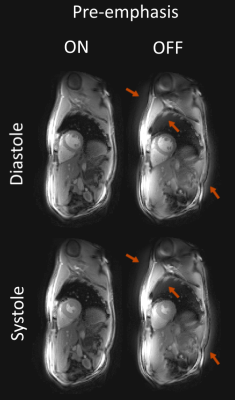 |
40 | Spiral imaging using a fully automatic pre-emphasis based on the Gradient System Transfer Function (GSTF)
Philipp Eirich, Tobias Wech, Manuel Stich, Julian Richter, Thorsten Bley, Herbert Köstler
The Gradient System Transfer Function (GSTF) was used to implement a fully automatic gradient pre-emphasis, enabling double-oblique MR imaging for arbitrary k-space trajectories. The developed method was tested using a standard 2D FLASH spiral sequence with several orientations in a structural phantom and an exemplary in vivo cardiac study.
|
|
0931. 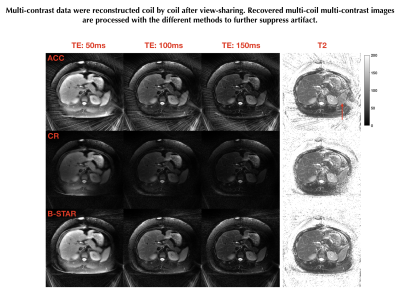 |
41 | Radial streak artifact reduction in multi-contrast imaging and parameter mapping using beamforming
Sagar Mandava, Mahesh Keerthivasan, Diego Martin, Maria Altbach, Ali Bilgin
Streaking artifacts are a common source of image quality degradation in radial MRI even with sufficient sampling. While coil removal is popularly used to mitigate streaking artifacts, this method is known to suffer from undesirable signal loss. Recently, a streak artifact reduction method has been proposed that offers a better balance between artifact reduction and signal retention. This approach endows the channel combination maps with the ability to suppress streaking artifacts and is implemented as a post-processing step. In this work, we present a computationally efficient refinement of this approach and extend it to multi-contrast imaging and parameter mapping applications.
|
|
0932. 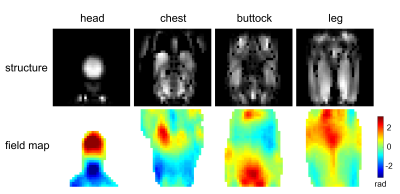 |
42 | Template-based field map prediction for whole-body shimming applications
Yuhang Shi, Hui Liu, Lingzhi Hu
For a whole-body scan, shimming are required to be carried out in multiple bed positions to provide homogeneous field for imaging different body parts. Thus, techniques to shorten the shimming time are required. This work presents a rapid B0 field prediction method for whole-body shimming based on a large field map database of different body parts. A range of applications could benefit from this technique.
|
|
0933 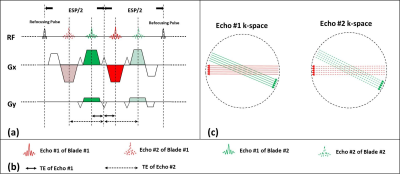 |
43 | A novel method combining Dixon water-fat separation and BLADE imaging Video Permission Withheld
Kun Zhou, Dehe Weng, Fang Dong, Wei Liu, Yulin V Chang
Fat suppression and motion artifacts are still challenging in clinical MRI for certain body regions. In this work a novel acquisition method combining Dixon’s method and BLADE (or PROPELLER, periodically rotated overlapping parallel lines with enhanced reconstruction) is proposed, to address fat suppression and motion artifacts simultaneously. We show that the proposed technique acquires data efficiently while avoiding the potential misalignment between echoes as well as the phase inconsistency introduced by different readout directions.
|
|
0934. 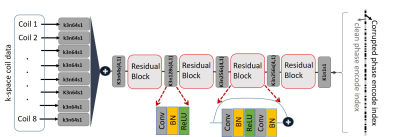 |
44 | Deep CNN for Outlier Detection: A Complementary Tool to Low-Rank based Methods for Reducing Motion Artefacts
Mark Bydder, Vahid Ghodrati, Fadil Ali, Peng Hu
Motion is common in MR image acquisitions. It causes artefacts in image quality that requires repeated scans, increasing the burden for patients and providers. There have been advances on hardware and software fronts in the quest to avoid such issues. The latter include data consistency methods which require no additional installation but can fail to detect high frequency outliers in k-space. We propose a Deep CNN approach to detect motion-corrupted phase encode lines, coupled with a low-rank reconstruction. This approach improves outlier detection in comparison to low-rank only methods and accelerates reconstruction time.
|
|
0935. 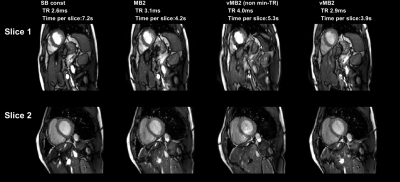 |
45 | Cardiac bSSFP accelerated using minimum-TR multiband RF pulse design and GIRF-correction
Samy Abo Seada, Anthony Price, Joseph Hajnal, Shaihan Malik
Cardiac balanced SSFP using simultaneous multi-slice acquisition is limited by RF pulse duration and SAR. The interplay of these constraints means that the minimum pulse duration does not usually yield the minimum TR. We show that multiband RF pulses designed using VERSE to directly minimize TR can yield a reduced TR. The result is demonstrated in a multiband-2 sequence on a 3T clinical system where the TR is only 15% longer than for single-slice excitation and the time per slice is reduced by 44%.
|
 Back to Program-at-a-Glance |
Back to Program-at-a-Glance |  Back to Top
Back to Top